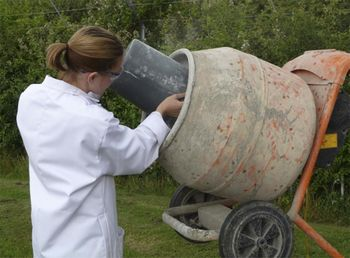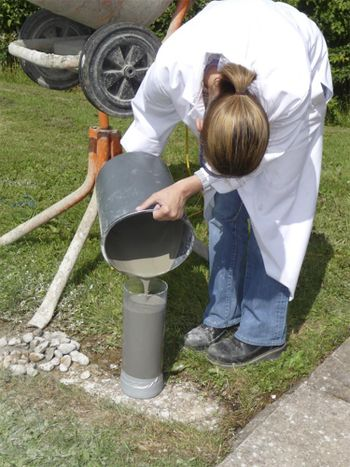OR/14/048 Starting materials
| Rochelle, C A, Purser, G, and Milodowski, A E. 2014. Results of laboratory carbonation experiments on NRVB cement. British Geological Survey Internal Report, OR/14/048. |
The cement composition used is that of the ‘Nirex reference backfill cement’ (NRVB) (Francis et al., 1997)[1]. This was chosen so that the results from the present study would be comparable with different measured parameters/datasets from earlier studies. It is acknowledged however, that the compositions of backfill cements used in any future repository may well be different to the composition used in this study, but it is thought that many of the mineralogical reactions we may observe are likely to be common to a wide-range of cements.
The composition of the starting cement is as follows:
- Portland Cement (‘Ordinary Portland cement’, from Hanson) = 450 kg/m3
- Limestone flour (‘Superlon 100’, from Longcliffe Ltd) = 495 kg/m3
- Lime (‘Hydralime’, from Lafarge) = 170 kg/m3
- Water (mains tap water) = 615 kg/m3
These were thoroughly mixed together over several minutes in a portable mixer to form fine slurry (Figure 1). A sufficient quantity (approximately 50 kg) of cement slurry was prepared in a single batch to provide an excess of material for use in the FORGE project. The cement was then poured into several plastic moulds and allowed to set (Figure 2). As the cement was prepared as a single batch, all the resulting cylinders of cement should have identical composition.


Once in the moulds the cement was left to set at 40°C for 24 hours. The plastic moulds were then removed, and the cylinders of cement cured for 40 days immersed in water saturated with Ca(OH)2 at 40°C and 1 bar pressure. The presence of the Ca(OH)2 was to minimise the potential for the outer parts of the cement to dissolve in the water. Being immersed in water also allowed pores within the cement to be fully saturated, and also to uptake extra water as remaining high temperature clinker phases slowly hydrated. After curing, the cement was stored in Ca(OH)2-saturated water in a sealed container at room temperature (20°C) and 1 bar.
Aqueous solutions
The fluids used in the experiments were of three types:
- A synthetic, young near-field porewater (YNFP) representative of the initial Na/K/Ca-rich pore fluid composition.
- A slightly modified version of the above with chloride added (YNFP+Cl) to represent a fluid having a composition intermediate between (1) and (3).
- A synthetic evolved near-field groundwater (ENFG) representative of the later Ca-rich pore fluid that will exist once local groundwater starts to perculate through the cement backfill.
The fluids used in this study were based on those reported in Francis et al. (1997)[1]. They are representative of those anticipated in the vicinity of a cementitious waste repository, and are broadly similar to those used in previous experimental studies Rochelle et al., 1994[2], 1997[3], 1998a[4], b[5], c[6] which in turn used compositions based upon previous modelling studies (Bond et al., 1995a[7], b[8]) (see Table 1 for composition, and Appendix 1 for fluid chemical analytical results).
Gases
Two gases were used in the experiments: carbon dioxide (CO2) and nitrogen (N2).
CO2
The CO2 used in this study was sourced from high purity (99.99%) liquid CO2 (Air Products, 4.5 Grade). This liquid CO2 was obtained in a cylinder fitted with a dip tube and pressurised with 2000 psi (approximately 14 MPa) of helium. However, the actual experimental pressure was controlled by an ISCO syringe pump, which has its pressure transducer periodically ‘zeroed’ to minimise drift. As the liquid CO2 at room temperature was piped to the experiments in the incubator, the increase in temperature caused it to become a lower density (supercritical) phase. Recorded pressures were taken from the ISCO pump controller readout.
N2
The N2 used in this study was obtained from BOC Gases and classified as ‘oxygen free’ (99.998% pure). It was delivered in a cylinder pressurised to 230 bar (23 MPa). However, the actual experimental pressure was controlled by an ISCO syringe pump, which has its pressure transducer periodically ‘zeroed’ to minimise drift. Recorded pressures were taken from the ISCO pump controller readout.
| Chemical component | YNFP (mol l-1) | YNFP+Cl (mol l-1) | ENFG (mol l-1) |
| pH | c.13 (at room temperature) | c.12.5 (at room temperature) | 12.4 (at room temperature) |
| Na | 7.1 x 10-2 | 7.1 x 10-2 |
3.9 x 10-1 |
| K | 9.3 x 10-2 |
9.3 x 10-2 |
3.9 x 10-3 |
| Ca | 3.6 x 10-3 |
3.6 x 10-3 |
5.2 x 10-2 |
| Sr | 3.0 x 10-4 | ||
| Cl | 1.64 x 10-1 |
4.3 x 10-1 | |
| Br | 3.2 x 10-4 | ||
| SO42- | 1.1 x 10-2 | ||
| SiO2 | 8.0 x 10-4 |
8.0 x 10-4 |
2.6 x 10-5 |
| Chemical component |
YNFP (grammes added per 2 litres of distilled de-ionised water) |
YNFP+Cl (grammes added per 2 litres of distilled de-ionised water) |
ENFG (grammes added per 2 litres of distilled de-ionised water) |
| CaO | 0.3366 |
0.3366 |
- |
| CaCl2.2H2O | - |
22.7739 | |
| NaOH | 5.6249 |
3.7147 | |
| NaCl | - |
8.2988 |
37.5767 |
| KOH | 10.4344 |
||
| KCl | - |
13.8660 |
0.5341 |
| SrCl2.6H2O | - |
0.1602 | |
| SiO2 | † 96.125 |
† 96.1738 |
† 3.2019 |
| Na2SO4 | - |
3.1246 | |
| KBr | - |
0.0762 |
† g BDH 1000 mg l-1 standard SiO2 solution added.
References
- ↑ 1.0 1.1 FRANCIS, A J, CATHER, R, AND CROSSLAND, I G. 1997. Development of the Nirex reference vault backfill; report on current status in 1994. Nirex Science Report S/97/014, United Kingdon Nirex Limited, 57p.
- ↑ ROCHELLE, C A, BATEMAN, K, COOMBS, P, PEARCE, J M, and WETTON, P D. 1994. The evaluation of chemical mass transfer in the disturbed zone of a deep geological disposal facility for radioactive wastes. IX. Further reactions involving discs of Borrowdale Volcanic Group lithologies with synthetic evolved near-field groundwater. British Geological Survey Technical Report WE/94/44, 30p.
- ↑ ROCHELLE, C A, PEARCE, J M, BATEMAN, K, COOMBS, P, and WETTON, P D. 1997. The evaluation of chemical mass transfer in the disturbed zone of a deep geological disposal facility for radioactive wastes. X. Interaction between synthetic cement porefluids and BVG: Observations from experiments of 4, 9 and 15 months duration. British Geological Survey Technical Report, WE/97/16C, 79p.
- ↑ ROCHELLE, C A, BATEMAN, K, COOMBS, P, PEARCE, J M, and WETTON, P D. 1998. The evaluation of chemical mass transfer in the disturbed zone of a deep geological disposal facility for radioactive wastes. VIII. Further reactions involving powdered Borrowdale Volcanic Group lithologies with synthetic evolved near-field groundwater. Nirex Report NSS/R393, 33p.
- ↑ ROCHELLE, C A, BATEMAN, K, MACGREGOR, R, PEARCE, J M, PRIOR, S V, SAVAGE, D, and WETTON, P D. 1998. The evaluation of chemical mass transfer in the disturbed zone of a deep geological disposal facility for radioactive wastes. VI. The hydrothermal aging of discs of bulk rock and near-fracture Borrowdale Volcanic Group lithologies with a synthetic evolved near-field groundwater. Nirex Report NSS/R390, 34p, 1998.
- ↑ ROCHELLE, C A, BATEMAN, K, MACGREGOR, R, PEARCE, J M, SAVAGE, D, and WETTON, P D. 1998. The evaluation of chemical mass transfer in the disturbed zone of a deep geological disposal facility for radioactive wastes. V. Reaction of powdered Borrowdale Volcanic Group lithologies with synthetic evolved near-field groundwater. Nirex Report NSS/R382, 24p.
- ↑ BOND, K A, MORETON, A D, and TWEED, C J. 1995. Water compositions of relevance to a deep cementitious-based repository at Sellafield: Evaluation using thermodynamic modelling, Nirex Report NSS/R310, 25p.
- ↑ BOND, K A, and TWEED, C J. (1995). Groundwater compositions for the Borrowdale Volcanic Group, Boreholes 2, 4 and RCF3, Sellafield, evaluated using thermodynamic modelling, Nirex Report NSS/R397, 34p.